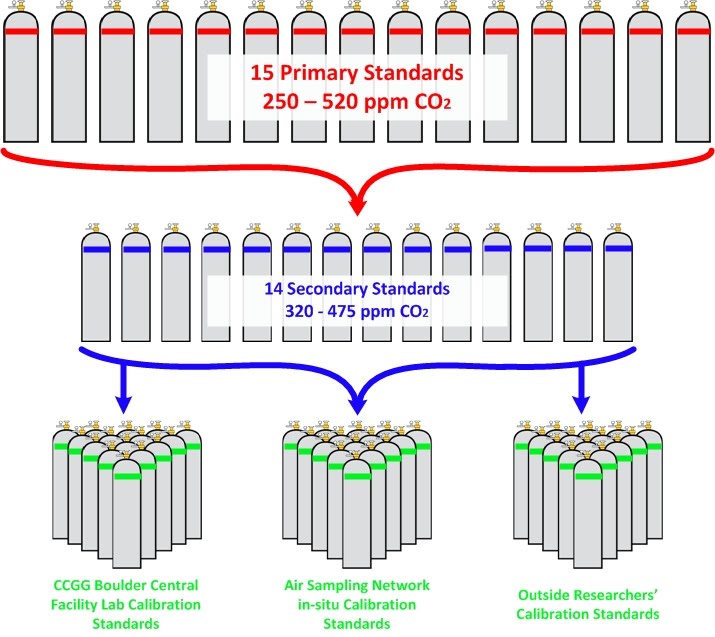Calibration Laboratory


The Calibration Lab is a vital part of CCGG’s greenhouse gas measurement program. Calibration is the process of ensuring that all of the greenhouse gas measurements (in the lab here in Boulder, at the tall towers and observatories, and at other labs around the world) are all extremely accurate. The CCGG Calibration Lab has been designated by the World Meteorological Organization (WMO) [The official United Nations' authoritative voice on weather, climate and water.] as the world's Central Calibration Lab (CCL) for the most important greenhouse gas, CO2. The purpose of this lab is to provide project and replacement standards with continuity over time, regardless of when and where they are used. This is how many different researchers over the world can compare and assimilate each others data without errors introduced by measurement differences.
What Exactly Is A Calibration?
Just like in a spy movie where everyone has to synchronize their watches, all the greenhouse gas instruments have to be synchronized. The Calibration lab is the equivalent of the atomic clock [Did you know that the world’s atomic clock happens to live just a few hundred yards away from the Calibration Lab here in Boulder, Colorado?]. Like the atomic clock, which uses an extremely accurate method to determine the time, the Calibration Lab uses an extremely accurate method to determine the amount of CO2 (and other gases) in tanks of air. This extremely accurate method is too complex and expensive to use for every measurement that we make, so instead we “reference” all of our measurements back to the Calibration Lab's measurements on a regular basis in the same way that you reset your watch once in a while (your cellphone automatically checks on the atomic clock time and resets itself too).

Primary Standards
The Primary standards (Primaries) are our “atomic clock”, and are measured using a very precise absolute measurement measuring system called the Manometric System [See how this measuring system works in the "How is CO2 Measured in Primary Standards & What is the Manometric System?" section]. There are 15 closely-spaced Primaries that have concentrations of CO2 ranging from 250 ppm to 520 ppm, which spans the limits of what we might find in the atmosphere (the "ambient range"). These Primaries have been measured over and over for more than 20 years to ensure that their CO2 concentrations are stable over time. In fact, we know their CO2 concentrations to better than 0.0003%. The assigned concentrations make up the CO2 calibration scale. If the Primaries change we can reassign a concentration and adjust the scale accordingly. There is a backup set of each closely-spaced Primary as well that is currently being repeatedly measured over time in order to be well-known standards that can be used to replace the original 15 closely-spaced Primaries when they are used up. There are additional widely-spaced Primaries being made that extend the range of CO2 concentrations in air from 75 ppm to 3000 ppm. These widely-spaced Primaries are used when researchers request standard tanks with extremely high or low CO2 concentrations (outside the "ambient range").
Secondary Standards
The Primaries are precious, so a set of Secondary standards (Secondaries) are referenced to the Primaries and then used for day-to-day calibrations of Tertiary standards that go out to the various researchers across the world. Secondary standards typically last 2 - 10 years, much shorter than Primaries, due to their more frequent use. Over time there have been many Secondaries, but at any given time there are about 14 Secondaries in use. To learn how the Secondaries are calibrated (or referenced) to the Primaries, check out the "How are Secondary and Tertiary standards calibrated for CO2?" section. Like the Primaries, the Secondaries have CO2 concentrations spanning the "ambient range" as well. There is also a backup copy of each Secondary waiting in the wings in case of an accident or heavy usage.
Tertiary Standards
The Tertiary standards (Tertiaries) are the "working" standards of the world and are referenced to the Secondaries using the same calibration process. This means the Tertiaries are referenced back to the Primaries, and thus the calibration scale is carried down the line through these Tertiary standards. Tertiaries are used within the various labs in the CCGG Boulder Central Facility, throughout the Air Sampling Network, and by outside researchers from many international laboratories, universities, and private companies. Depending on how much the Tertiary standards are used by researchers, they could last months to years. Sometimes these Tertiary standards are used to create other standards by fellow researchers for their projects.

 Previous
Previous